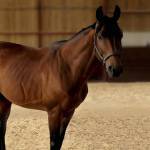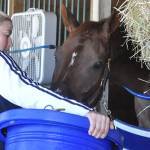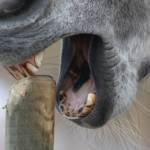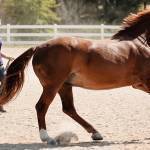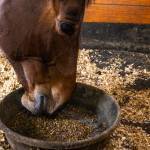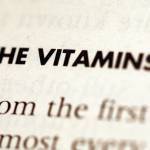Question
My 1,225-lb (555-kg) Quarter Horse mare was recently diagnosed with recurrent exertional rhabdomyolysis. She is usually worked six days a week, for about 45 minutes each day with hacking and low-level jumping. She is kept in a stall 18 hours each day and is turned out 6 hours each day. She is fed 6 lb of alfalfa hay three times each day (8 a.m., noon, 5 p.m.). She receives 2 lb of a low-starch feed two times a day (8 a.m. and 5 p.m.). I need to change her diet to address her muscle problems, but I don’t have access to premium-quality feeds like Re-Leve where I live. Can you help me concoct a diet that is appropriate for my mare, please?
Answer
Recurrent exertional rhabdomyolysis (RER) is a syndrome of repeated episodes of tying-up, characterized by painful muscles, lameness, sweating, and a reluctance to move after moderate exercise. Careful consideration to the nutritional management of horses diagnosed with RER can often alleviate the occurrence of symptoms.
A couple of suggestions for your mare:
(1) If possible, switch the mare from alfalfa to grass hay. Research has shown that horses with RER do better on grass hay. If you cannot get all of the alfalfa out of the diet, try to minimize the impact by giving some grass hay in addition to a lesser amount of alfalfa. We recommend feeding a minimum of 1.5% of the horse’s body weight in hay, so for your mare you are right on with the 18 lb a day she is currently getting. However, if you switch to grass hay, she may need more to maintain her weight because grass hay is not as calorie-dense as alfalfa.
(2) Rice bran is a good option for a horse with RER and has been researched as a viable energy source over traditional higher starch diets. Be sure to get a stabilized rice bran, as raw rice bran has serious fat rancidity issues. Two pounds per day is the recommended amount for a horse with RER. Rice bran is a supplement and not a balanced feed like Re-Leve, so there are other components you will need to keep balanced in the diet.
(3) Switch the low-starch feed for a ration balancer. The problem with feeding only 2 lb per day of a low-starch feed is that it is below the recommended feeding rate and your horse will be short on vitamins and minerals. If you go with the rice bran, the best way to complement or balance the diet would be with a ration balancer like All-Phase from KER Sport Horse Nutrition. If you are feeding a ration balancer at 2 lb per day (1 lb per feeding), then you should not need to supplement with vitamin E and selenium because there should be adequate amounts in the balancer. If you are only feeding 2 lb a day of the low-starch feed, there is not enough vitamin E and selenium to meet the horse’s requirements. More information on ration balancers can be found here.
4) If you implement these suggestions, I don’t think you would need to add any beet pulp. However, if your mare does not maintain her weight on 18-24 lb of grass hay, 2 lb of rice bran, and 2 lb of ration balancer, then you could consider increasing the calories in the diet by adding some beet pulp.
I am sure you have researched RER, but I thought maybe you would be able to find some valuable information in these articles from our archives:
Recurrent Exertional Rhabdomyolysis: A Muscle Problem in Horses
The University of Minnesota has an excellent website that contains detailed information about RER. The scientists there are at the forefront of muscle disease research, and Kentucky Equine Research has done numerous collaborative studies with them.

